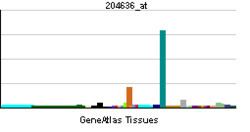Entrez 1308 | Ensembl ENSG00000065618 | |
 | ||
Aliases COL17A1, BA16H23.2, BP180, BPA-2, BPAG2, LAD-1, ERED, collagen type XVII alpha 1 External IDs OMIM: 113811 HomoloGene: 133558 GeneCards: COL17A1 | ||
Collagen XVII, previously called BP180, is a transmembrane protein which plays a critical role in maintaining the linkage between the intracellular and the extracellular structural elements involved in epidermal adhesion.
Contents
This gene encodes the alpha chain of type XVII collagen. Collagen XVII is a transmembrane protein, like collagen XIII, XXIII and XXV. Collagen XVII is a structural component of hemidesmosomes, multiprotein complexes at the dermal-epidermal basement membrane zone that mediate adhesion of keratinocytes to the underlying membrane. Mutations in this gene are associated with both generalized atrophic benign and junctional epidermolysis bullosa. Two homotrimeric forms of type XVII collagen exist. The full length form is the transmembrane protein. A soluble form, referred to as either ectodomain or LAD-1, is generated by proteolytic processing of the full length form.
Structure
Collagen XVII is a homotrimer of three alpha1(XVII)-chains and a transmembrane protein in type II orientation. Each 180 kD a-chain contains a globular intracellular domain of approximately 70 kDa, which interacts with beta4-integrin, plectin, and BP230 and is necessary for the stable attachment of hemidesmosomes to keratin intermediate filaments. The large C-terminal ectodomain with a molecular mass of approximately 120 kDa consists of 15 collagenous subdomains, characterized by typical collagenous G-X-Y repeat sequences, flanked by 16 short non-collagenous stretches. The overall structure of the ectodomain is that of a flexible, rod-like triple helix with a significant thermal stability. The membrane proximal part of the ectodomain, within amino acids 506-519, is responsible for binding to alpha 6 integrin, this binding seems to be important for the collagen XVII integration into hemidesmosomes (citation needed). The largest collagenous domain, Col15, which contains 232 amino acids (amino acids 567-808), contributes significantly to stability of collagen XVII homotrimer. The C-terminus of collagen XVII binds to laminin 5, and correct integration of laminin 5 into the matrix requires collagen XVII.
Pathology
Mutations in the human collagen XVII gene, COL17A1, lead to the absence or structural alterations and mutations of collagen XVII. The functional consequences include diminished epidermal adhesion and skin blistering in response to minimal shearing forces . The disorder is called junctional epidermolysis bullosa, an autosomal recessive skin disease with variable clinical phenotypes. Morphological characteristics of junctional epidermolysis bullosa are rudimentary hemidesmosomes and subepidermal tissue separation. Clinical hallmarks, in addition to blisters and erosions of the skin and mucous membranes, include nail dystrophy, loss of hair, and dental anomalies. Collagen XVII also plays a role as an autoantigen in acquired subepithelial blistering disorders. Most immunodominant epitopes lie within the NC16A domain, and the binding of the autoantibodies perturbs adhesive functions of the collagen XVII, and this (together with inflammation-related processes) leads to epidermal-dermal separation and skin blistering.
Shedding
Collagen XVII is constitutively shed from the keratinocyte surface within NC16A domain by TACE (TNF-Alpha Converting Enzyme), metalloproteinase of the ADAM family. The shedding is lipid raft dependent. Collagen XVII is extracellularly phosphorylated by ecto-casein kinase 2 within the NC16A domain, phosphorylation negatively regulates ectodomain shedding.
SPARC and Osteogenesis Imperfecta
The SPARC gene is completely associated with homozygous mutations in collagen XVII, which in turn causes a type of osteogenesis imperfecta. osteogenesis imperfecta type XVII
Interactions
Collagen, type XVII, alpha 1 has been shown to interact with Keratin 18, Actinin alpha 4, Dystonin, Actinin, alpha 1, CTNND1 and ITGB4.
